Introduction
Sustainability refers to the productive capacity of an organisation, as measured against an uncertain future. This also takes into consideration socioeconomic factors that include higher welfare, well-being, and other improvements. One of the fundamental criteria of socio-economic sustainability is labour productivity. Therefore, the industrial sector is crucial for economic and social development.
Goal 8 of the United Nations Sustainable Development Goals (SDG) focuses on attaining a higher level of economic productivity (sdgs.un.org, 2022). This can be accomplished by concentrating on high value-added as well as labour-intensive sectors. It should also be complemented by achieving productive employment with equal compensation for the equivalent value of work, that can create a sustainable labour market.
The relationship between employee productivity and wage is that it boosts employees’ standard of living and balances income distribution between labour and capital. Hence, productivity and wages have become a primary socio-economic priority for every nation.
Therefore, this article strives to expand the discussion of the Productivity-Linked Wage System (PLWS) as a mechanism for boosting productivity and competitiveness in Malaysia. Specifically, it is intended to enhance understanding of the notions, goals, potential advantages, and best practices of PLWS.
Briefing on PLWS
Gaps in the economic growth and standard of living among various nations can occur due to employee productivity. We need to consider that a country’s ability to improve quality of life over time relies on its ability to improve the output of employees. Furthermore, it is widely acknowledged that productivity and wages will increase when the nation becomes more competitive and developed. Therefore, employees must acquire substantial gains from increased employee productivity to achieve a standard of living through the increase in given wages (Bahman, Muhammad, Imansah, Sin & Bsar, 2020).
PLWS is a flexible and competitive wage system that allocates wealth created based on employers and employees performance as well as productivity to enhance the firm’s shared prosperity and competitiveness.
Moreover, the adoption of PLWS was pinpointed as a priority under the Shared Prosperity Vision 2030 and Malaysia Productivity Blueprint to increase compensation and establish a future workforce. The PLWS aligns organisational policies, inspires employees and boosts job satisfaction. It also enables skills-related specialisations, professional career advancements and forms equitable interactions between employers and employees. (Bernamamrem.com, 2021).
Therefore, Vinod (2020) stated that enterprises that embrace the PLWS experience improve teamwork and build a healthier workforce with a stronger sense of belonging to the firm among employees. Consequently, flexibility in the employees’ remuneration systems and workers’ positivity results in employee-employer engagements as well as harmonious industrial relations.
Phases of PLWS Implementation
The Economic Outlook 2020 Report (EOR 2020) emphasises that implementation of PLWS remains low in Malaysia. However, Lee (2019) declared that under EOR 2020, the government will continue to broaden the adoption of PLWS to assure that wages correlate with productivity levels. Furthermore, collaboration among different parties is vital for its smooth and successful implementation.
Nevertheless, enterprises should adopt the following five (5) steps to succeed in their PLWS implementation journey.
- Raising awareness on the PLWS
- Formulation of measurement tools
- Switching to a new system
- Adoption of PLWS
- Constant evaluation and enhancement of existing PLWS
Generally, an organisation’s management board is responsible for thoroughly explaining the system’s advantages to the union and employees. In addition, bilateral meetings and discussions need to be held regularly to acquire feedback and ideas from the members. Furthermore, an internal committee designated by employees from every department must be established to develop a performance measurement system that is fair, easy to understand, and mutually agreed upon by both parties. The transition to a new system is a complex process. Therefore, distinctions between the existing and the new system must be grasped. Additionally, some flexibility should be given during the adoption period of the new system to enable employees to acquire essential information on any development and provide recommendations for improvement.
Lastly, selecting the implementation process relies on the type of industry and the contract between the employer and employees or trade union. However, this system should be reassessed in light of present economic conditions, organisational performance and individual productivity rate.
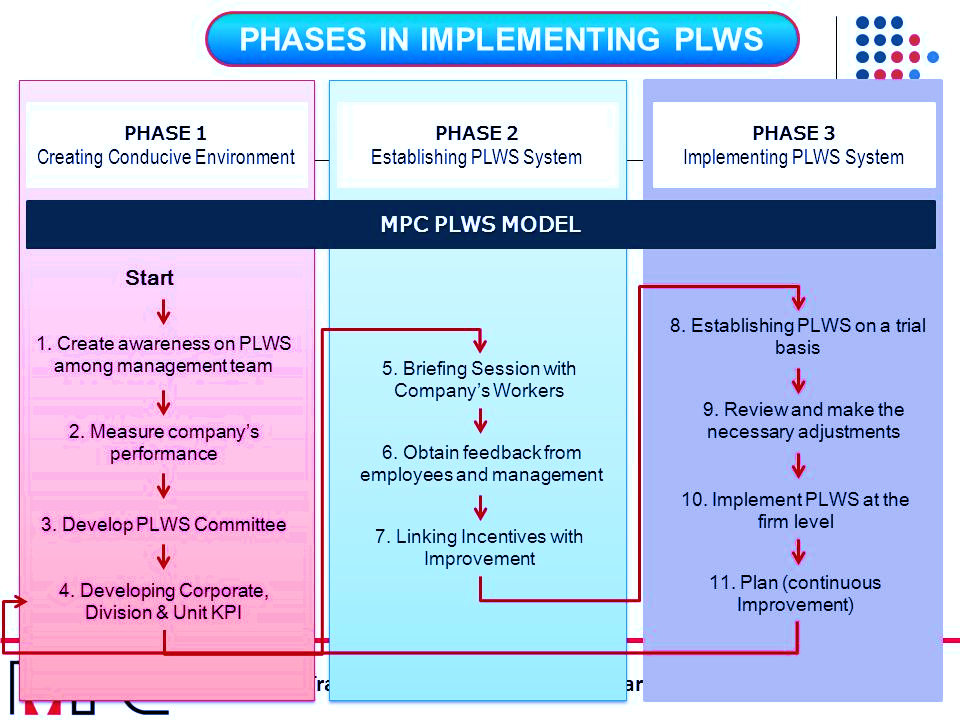
Objectives of PLWS Implementation
Economic development, greater productivity, and creating suitable employment levels have historically been vital aspects of macroeconomic objectives for policymakers. In developing countries in particular, economic development has consistently been the top priority.
Accordingly, PLWS strives to strengthen a connection between wages and productivity to boost competitiveness and assure job resilience. This is done by enabling employers to form a more comprehensive and systematic approach to enhancing productivity and wages via active participation and collaboration. Lastly, this system allows employees to receive a fair share of gains from productivity advancement, encouraging equity and social unity. Simultaneously, it enhances life quality while developing professional career advancement opportunities and job satisfaction.
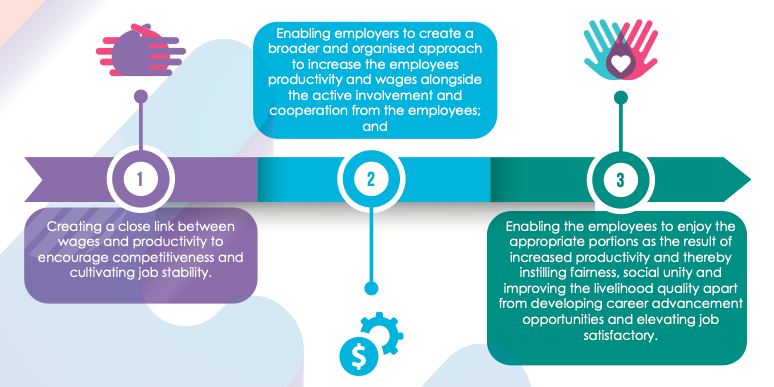
Benefits of PLWS Adoption
The PLWS benefits both employers and employees by assuring that both sides acquire a fair share of gains from productivity and performance advancement (StarNews, 2019). Unfortunately, despite the positive findings, PLWS implementation rates remains low. The primary reason is a lack of awareness of the advantages and importance of this system for the organisation’s members. However, the following factors are known as the major benefits of implementing PLWS.
- First, the wage payments will be modified according to economic performance, minimising the adverse effects on employers and employees.
- Second, it assures employment security and reduces the likelihood of layoffs during an economic recession.
- Thirdly, it forms a win-win condition for both parties.
- Fourthly, it enables organisations to adapt their policies in response to the current economic circumstances.
- Lastly, it boosts job specialisation according to competence and advances employees’ professional careers by increasing their motivation and job satisfaction.

Components of PLWS
Based on Nasira, Wub, Howesc, and Ripley (2022), decent wages have been deemed a sign of socio-economic progress. Thus, wage growth is vital for the public policy debate. According to the fundamental components of PLWS, wages should contain a combination of monthly earnings or other regular payments, annual salary increments, and yearly or irregular bonuses. Additionally, wages must also involve a fixed component, such as basic salary, as well as additional components in the form of variable payment.
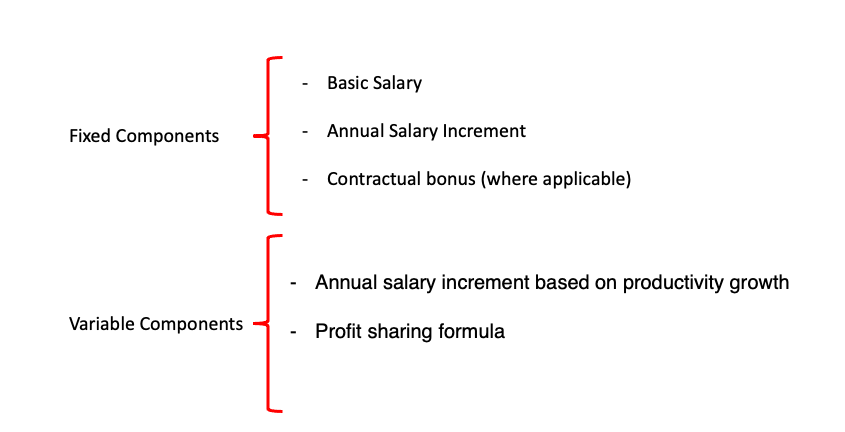
PLWS Models
In general, the PLWS can be based on three (3) different models, known as profitability, productivity, and integrated models.
Douglas (2018) stated that the profitability model comprises a fixed component integrated with a variable component determined by a profit-sharing formula. In addition, the variable component will be paid when the profits gained by the organisation surpass a pre-agreed level. Hence, this profit level can be determined using return on investment and average profits obtained over years.
Next, the second model is the productivity model, which contains a fixed component and a variable component defined by a productivity-sharing formula. In addition, the formula is T = A + P, where T = total wage increase, A = annual increment and P = variable productivity payment. In this case, productivity can be measured as worker performance, production efficiency, total factor productivity, or a total average of numerous key performance indicators. Finally, the last model is the integrated or combined model, which combines profitability and productivity (Douglas, 2018).
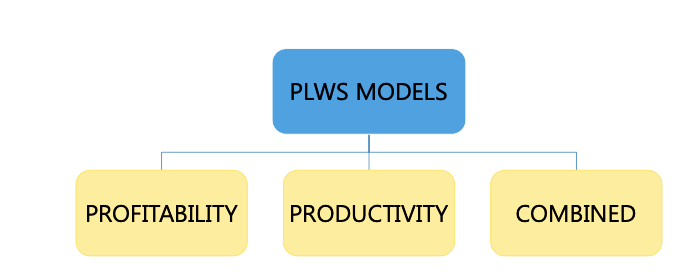
PLWS Elements
Vinod (2020) declared that the PLWS is advantageous for companies because it reflects mutual benefits for employers and employees, allocating incentives according to their performance and productivity. He added that the system also helps enterprises recover more quickly and navigate skilfully when organisational members proceed ’hand-in-hand’. The table below depicts the elements of the PLWS, followed by their clarifications.
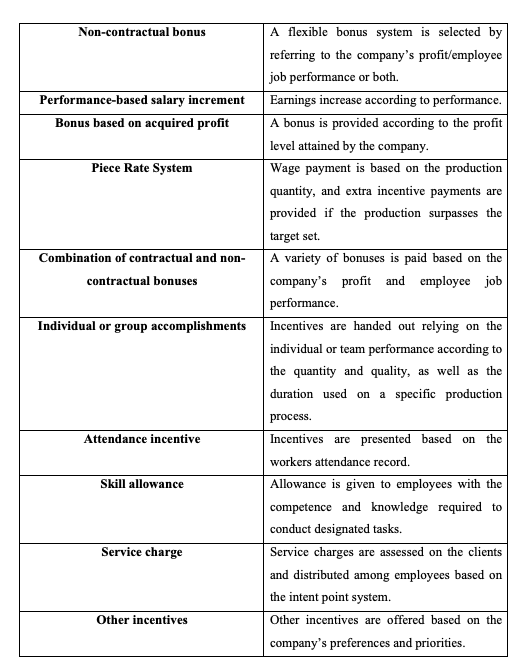
Obstacles to PLWS Implementation
Companies are encouraged to enforce PLWS to boost long-term competitiveness through enhanced productivity (StarNews, 2003). However, some obstacles and issues that discourage companies from adopting this system are listed below.
- Companies are unaware that PLWS helps in enhancing productivity and performance.
- The uncertainty that PLWS adoption will improve the company’s competitiveness.
- Employees and unions are not familiar with and unaware of the implementation of PLWS.
- The company’s top management may not always support PLWS.
- Due to high implementation costs, several companies may not feel compelled to adopt PLWS.
- Uncertainties can be caused among organisations as they might think PLWS is not a fair system for both employees and employers. Hence, they believe it is unnecessary to change the current pay system to PLWS.
CASE STUDY
PLWS Success Story from a Malaysian Company
Bumi Emas Services (BES) is a secretarial service company that provides a broad range of services such as company registration, business licensing, accounting, and book-keeping, which records the company’s financial transactions into structured accounts daily. The company was founded in March 2009 in Miri, Sarawak, by Siti Rahimah, who also became the company secretary and Chief Executive Officer (BES, 2022).

The company is one of Sarawak’s foremost providers of corporate secretarial services. BES strives to be competitive in aligning with the government’s goals of delivering quality and successful entrepreneurs.
One of the significant effects of adopting PLWS in BES was enhancing morals and ethics among employees and encouraging them to be more productive. Since the company was small the need to retain talent was a big priority. The PLWS has also broadened the scope of work, reinforced teamwork, stimulated collaboration and strengthened unity.
Moreover, the PLWS also formed a win-win situation for both management and staff in the company, as the productivity and effectiveness of employees was increased, leading to customer satisfaction and retention. According to BES, the constant support by the top management provided the assistance required to build PLWS within the company, and BES has enhanced its productivity by 30% since its introduction (BES, 2022).
On the other hand, the Malaysia Productivity Corporation (MPC) has engaged in strengthening efforts to raise awareness of PLWS and e-Shared Prosperity Organisation (eSPO) Acknowledgement Certificate.
Another excellent example of PLWS implementation is for KPJ Healthcare, due to it obtaining the eSPO Acknowledgement Certificate. Indeed, PLWS has been a critical component of its talent management, resulting in solid relationships among the staff and client satisfaction, as well as the hospital’s profitability and growth. The hospital and staff prospered and continue to develop together by acquiring mutual benefits from the adoption of PLWS (Bernamamrem, 2021).
Overall Discussion
In response to the rapid changes brought by globalisation, implementing the PLWS will improve Malaysia’s industrial productivity and competitiveness. The PLWS is enforced by the government to foster a work culture based on performance and productivity. Further, this system benefits employers and employees while also contributing to the development of the economy and stabilisation of the nation to compete in an aggressive global market.
Accordingly, as of June 2021, the director-general (Datuk Abdul Latif Abu Seman) declared that over 2,500 enterprises had been designated as ’shared prosperity organisations’, including numerous sectors such as manufacturing, services, construction, agriculture, mining as well as quarrying, to inspire SMEs to be identified for their resilience during the Covid-19 pandemic and for contributing to the nation’s economic recovery (StarNews, 2021).
Nonetheless, multiple factors primarily contribute to the successful adoption of this system. Firstly, the commitment of top management is required to guarantee that the system is successfully enforced at every level of management throughout the organisation. Secondly, accurate information exchange is essential to instil trust and prevent suspicion among employees or trade unions. Thirdly, a fair and transparent performance inspection mechanism must be developed to avoid doubts and mistrust. Finally, establishing a communication channel between employees and employers is crucial to keep employees updated on the progress of the PLWS implementation.

Overall, PLWS can be advantageous for organisations, government, individuals or employees, clients, and the country. The benefits for each party are displayed in the table below.
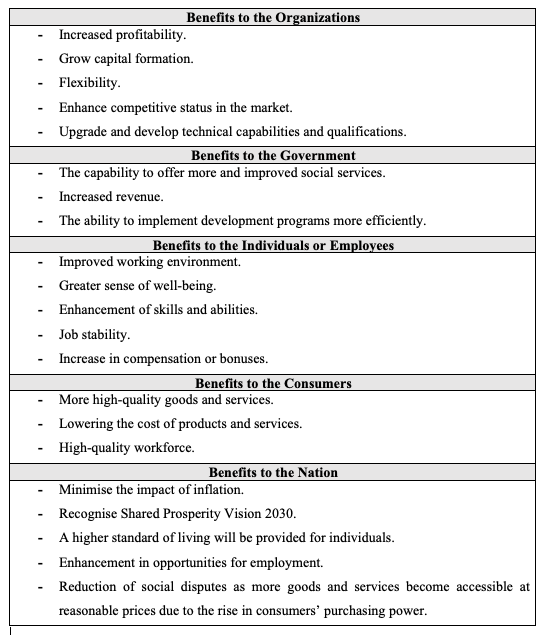
**The author would like to acknowledge and say thanks to Ms. Nazanin Dara, a Ph.D. Student from the University of Cyberjaya who assisted me in this research project. **
Professor Dr. Balakrishnan Parasuraman is a Professor of Management/HR/Industrial Relations at the Faculty of Entrepreneurship and Business, Universiti Malaysia Kelantan (UMK) based in Kota Bahru, Kelantan. He is a member of the International Honor Societies of the International Employment and Labor Relations Associations (IIRA) based in Geneva, Switzerland, Malaysian Institute of HRM, and International Employment Relations Association, Sydney, Australia.
Aligning Employee Commitment through Productivity-Linked Wage System (PLWS): Bumi Emas Services – Malaysia Productivity Corporation (MPC). (2022, January 13). Malaysia Productivity Corporation. https://bond.mpc.gov.my/bond2/best-practices/categories/item/850-aligning-employee-commitment-through-productivity-linked-wage-system-plws-bumi-emas-services.html
AliNasir, M., Wu, J., Howes, C., & Ripley, H. (2022). Asymmetric nexus between wages and productivity in the context of the global financial crisis. Journal of Economic Behaviour & Organization. https://www.sciencedirect.com/science/article/pii/S01672681220019
Mahasan, N. (n.d.). Productivity- Linked Wage System (PLWS). International Labour Organization (ILO). https://www.ilo.org/wcmsp5/groups/public/—asia/—ro-bangkok/—ilo-jakarta/documents/meetingdocument/wcms_645181.pdf
Basri, N., Karim, Z., & Sulaiman, N. (2020, October 20). The Effects of Factors of Production
Kadir, A., AlHosani, A., Ismail, F., & Sehan, N. (2019, July 30). The Effect of Compensation and Benefits Towards Employee Performance. Semantic Scholar. https://eudl.eu/pdf/10.4108/eai.30-7-2019.2287551
Shocks on Labor Productivity: New Evidence Using Panel VAR Analysis. MDPI. https://mdpi-res.com/d_attachment/sustainability/sustainability-12-08710/article_deploy/sustainability-12-08710-v2.pdf?version=1603289915
Salam, M., Lasise, S., & Munizu, M. (2022, February 21). The Effect of Compensation and Work Environment on Employee Productivity through Job Satisfaction as Intervening Variable. Hasanuddin Journal of Business Strategy. https://feb.unhas.ac.id/jurnal/index.php/HJBS/article/view/500/410
Workers’ Perception towards Minimum Wage Impacts on Labor Productivity in Malaysia (2020). American Journal of Humanities and Social Sciences Research (AJHSSR), from https://www.ajhssr.com/wp-content/uploads/2020/11/ZC20411238248.pdf



